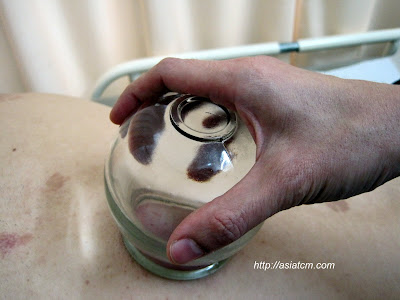In Traditional Chinese Medicine (TCM) Cupping (拔罐) is a method of applying acupressure by creating a vacuum on the patient's skin to dispel stagnation—stagnant blood and lymph, thereby improving Qi flow to release adhesions and help remove toxins from the body. Cupping is a simple yet powerful form of alternative healing.

Cupping is a process in which suction is used to relieve local congestion. Cupping methods create a negative pressure, or suction, on the skin that pulls up tissue and actively draws blood and other fluids close to the surface. This pulling action on the body engages the parasympathetic nervous system and induces a deep relaxation. Done correctly, cupping can be an effective complementary technique when used in conjunction with massage therapy.
Cupping is a process in which suction is used to relieve local congestion. Cupping methods create a negative pressure, or suction, on the skin that pulls up tissue and actively draws blood and other fluids close to the surface. This pulling action on the body engages the parasympathetic nervous system and induces a deep relaxation. Done correctly, cupping can be an effective complementary technique when used in conjunction with massage therapy.
Healers have performed this technique since ancient times by using heat inside glass or bamboo cups. The heated cups are usually applied to the back of the body on acupuncture points, or where pain is felt. They are left in position for five to 15 minutes, depending on the strength of the suction. The suction created draws blood and other fluids closer to the surface of the skin allowing the body to rid itself of toxins more easily.
The suction can be light, medium or strong depending on whom it is used and which tools are utilized. For example, light cupping or suction is appropriate for children and the elderly, while strong cupping is contraindicated for them. There is also massage cupping, sometimes referred to as moving cupping, after applying small amount of oil to the skin to facilitate the cupping movement, the cups are glided over the surface of the skin.
Cupping can be used for many pathologies, most of which are considered to be caused by stagnation or congestion of energy, blood or mucus as categorized by TCM. For example, cupping can be used to help relieve headache, back pain, respiratory disorders, such as colds, flu and asthma, dizziness, coughing, asthma, indigestion, sleeplessness and stomach ache. In these cases, a professional TCM practitioner is required.
There are also several conditions in which cupping should not be used, such as pregnancy or on clients with hemorrhagic diseases like leukemia or hemophilia; nor should it be used on inflamed or broken skin, or if the client has a fever. Cupping is not very effective on areas of the body where there is a lot of hair or angular areas. It is most effective on large smooth areas of the body, such as the back or thigh.
While cupping is an extremely effective treatment for colds, flu, for a wide variety of muscle strain injuries and for drawing out toxins, it does tend to leave large areas of bruising. Bruising and, occasionally, blistering, following the shape and size of the cup will generally occur. The color of bruises signifies the patient's health. Dark bruises indicate serious blocked blood and energy or a serious pathogenic cold invasion. The darker, the more serious. Anyway, these bruises are not dangerous and disappear in a few days.
To learn more about TCM Cupping Therapy in Singapore, or if you are interested in finding ways to detoxify your body, feel free to visit Asia TCM Singapore Clinic. Our Singapore TCM practitioners are well experience in using cupping therapy to treat patients.
